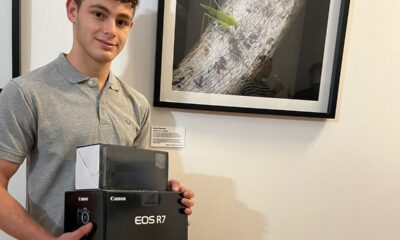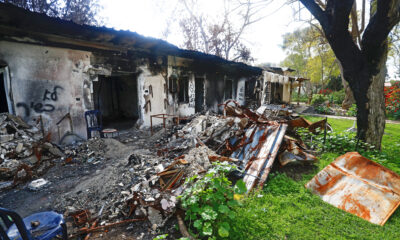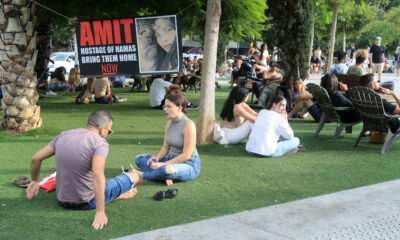
Lifestyle

Portrait of a gritty city
Photographic artist Caroline Suzman has an exhibition, I Declare I am Here, at the Wits Art Museum. The SA Jewish Report speaks to her about it.
What made you choose this medium?
My parents gave me a box brownie camera for my birthday when I was six, and it opened a whole world of seeing things – it was like a cube of magic. I love architecture, art, design, and portraiture, and exploring social issues in a nuanced way. Photography allows me to combine so many different elements.

What do you look for in a project?
I look for a hook – a picture that sparks thoughts about a particular subject. The thoughts often have literary or historical references, or might radiate from a poem, which often happens as I love poetry and find that poetry and photography go particularly well together. This can be expanded into a narrative that can be explored in various ways – literal, allegorical, metaphorical.
I like projects that can be layered in this way. An example of this is my series, Expectations. I found myself repeatedly driving past a man with a grass kiosk in Greenside and the stack of grass on the side of the road looked so inviting, I wanted to stop, even though I didn’t need grass. The grass seller had placed a large orange glove on top of the grass that to me said something about his expectation of selling grass. I expanded this idea into a series that reflects on our expectations of one another, parents’ expectations of children, children’s expectations of parents, and our expectations of the sensory world.
What inspired the photographs in your latest exhibition?
In 2016, I was standing in an underpass of the highway in Newtown. The rush of cars overhead, people streaming in and out of the city, creates a sense of time simultaneously standing still and feeling that you are hurtling into the future. The massive concrete pillars that prop up the highway seemed to bear down on me, it felt oppressive. I read somewhere that South African photographer David Goldblatt said that the reason he used black and white film during apartheid was that “colour was too sweet for apartheid”.
This series, I Declare I Am Here, is a kind of call and response to that statement. The photographs reflect on the powerful way that people stand their ground in a city that is at once inviting and at times inhospitable. The images are super saturated with the natural vibrancy of street art, and I have pushed the design elements to extremes, for example mixing traditional Ndebele design on a traditional costume with graffiti, symbolic of the old and the new, and the eclectic layering of the city’s diverse cultures.

The work reflects on people “reclaiming’” the city after the end of apartheid, taking a stand, and navigating the decaying urban infrastructure of Johannesburg with grit and grace. I was also inspired by the way many people dress on public holidays like Freedom Day and Heritage Day, which reflects a certain pride in the way they see themselves in relation to the city.
How did you choose your subjects?
As a portrait photographer, I’m always looking at people. I’m interested in how they feel about living in cities, and I’m interested in the themes of the city and country in general, like migrancy and xenophobia. Photographic portraits allow for reflection on social themes in a soulful way.
I drive and walk around Johannesburg a lot because I love the layered architecture, and there’s always something crazy and interesting happening on the street. While walking around, I always meet amazing people and I strike up conversations. Sometimes those people are dressed in a particular way that makes them stand out. In my mind, I fleetingly match their dress with some urban fabric (architecture, murals, graffiti, etc). Sometimes it works, sometimes not. Part of the experience is just the freedom of meeting people and the joy of taking in the urban fabric with no expectations.
What are you trying to portray?
I try to let my subjects radiate their own energy and portray whatever they want. I often just stand still until they almost forget they are being photographed, and they go into their own world. I like the moment of disengagement because it feels more natural.

How do you feel about Joburg?
Like many, I have a love/hate relationship with the city. The hate comes from the loss of freedom to walk around without having to be on guard because of crime, chronic social inequality, and xenophobia. What I love about Johannesburg is that people are so kind and friendly, creative, and innovative.
Street art plays a big part in this body of work. What does it represent to you?
I was concerned with the play between the social and urban fabric, not the street art in itself. The portraits have street art in them because much of Johannesburg is full of graffiti and street art. Street art is interesting because often it reflects social issues.
The very nature of street art is such that it comes and goes, it can get overpainted or vandalised in a heartbeat, and photography is a way of freezing the work in time and giving the artist ongoing recognition. When I’m able to identify the artist, I include their name in the caption of the work so that people can look them up. Many are involved in public-art projects which uplift communities by employing local people and beautifying spaces.

Over time, you have visually documented much of this country. Why?
Photographers have great power, and if you can, you should try use that power for good.
There are many issues in the country that need focus. One of them is land ownership. My great aunt, parliamentarian Helen Suzman’s, motto was, “Go and see for yourself”, and that’s exactly what I did. For 20 years on and off, I travelled thousands of kilometres, mostly on my own, to find out what was happening with rural violence, land reform, and restitution in South Africa. The result is a book project called Heartlands.
I also just love this country so much – and any excuse for a road trip, the longer and off the beaten track the better.

What’s next and why?
I’m working on a full-colour book of the series I Declare I Am Here, which will be published later this year.
I’m simultaneously working on a new series with a conceptual approach. It’s a collection of random, disturbing things in suburbia that are related to apartheid spatial planning. It’s a bit irreverent, a bit serious, a bit disturbing, and a bit funny.
I’m also working on my book, Heartlands, about land ownership in South Africa, and continuing my legacy nature project series – commissioned projects for games reserves, parks, and special gardens, creating records for future generations.
“I Declare I Am Here” is at the Wits Art Museum until 13 May. The gallery is open Monday to Saturday, 10:00 to 16:00. Suzman will be doing walkabout through the exhibition on Thursday 11 May, at 12:00; Friday 12 May at 12.30; and Saturday 13 May at 12:00 and 14:00.










